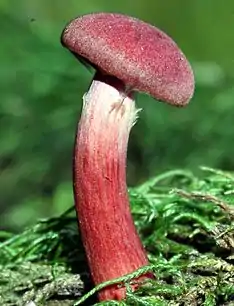Tubaria punicea
Tubaria punicea is a rare species of agaric fungus in the family Tubariaceae. It is found on the west coast of North America, where it grows on the bases and in hollows of madrone (genus Arbutus).
| Tubaria punicea | |
|---|---|
 | |
| In Henry Cowell Redwoods State Park, California, USA | |
| Scientific classification | |
| Kingdom: | |
| Division: | |
| Class: | |
| Order: | |
| Family: | |
| Genus: | |
| Species: | T. punicea |
| Binomial name | |
| Tubaria punicea (A.H.Sm. & Hesler) Ammirati, Matheny & P.-A.Moreau (2007) | |
| Synonyms[1] | |
| |
Taxonomy
The fungus was first described in 1968 by American mycologists Alexander H. Smith and Lexemuel Ray Hesler as Pholiota punicea. The type specimen was collected by Smith in November 1937 from a burned stump at the California–Oregon state line.[2] The species was transferred to Tubaria in 2007, in the section Confragosae, which contains species that either produce wine-red (vinaceous) fruit bodies or have a ring on the stipe. Other species in the section include T. rufofulva, T. vinicolor, T. confragosa, T. bispora, and T. serrulata.[3] The Latin specific epithet punicea means "reddish-purple".[4]
Description

Fruit bodies have caps that are initially hemispherical to convex, but later become flattened, sometimes developing a low, broad umbo; the cap diameter is 1–5 cm (0.4–2.0 in). Its surface is dry, and its color vinaceous, with lighter margins. The cap margin is curved downward, and has faint radial grooves. It may be irregular in instances where fruit bodies have grown together in clusters. The gills have an adnate to somewhat decurrent attachment to the stipe. They are somewhat closely spaced. Initially deep vinaceous, they become brownish with a reddish tinge after the spores mature. The stipe measures 2–9 cm (0.8–3.5 in) long by 2.6–6 mm (0.1–0.2 in) thick, and the same width throughout its length, or slightly thicker at the base. It has a fibrillose surface texture, and, in mature specimens, faint longitudinal grooves. It is wine-red with a whitish base. Young individuals have a silky white partial veil that later becomes fibrillose (as if made of threadlike fibers) and vinaceous in color. The flesh is reddish brown and lacks any discernible odor. The spore print is cinnamon brown.[3] Due to its rarity, the edibility of the mushroom has not been definitively established, but one report suggests that it is "harmless", with a flavor of "bland beef".[5]
Spores are typically 7.2–7.8 by 4.6–5.1 μm with a shape ranging from somewhat phaseoliform (bean-shaped) to elliptical to egg-shaped. The basidia (spore-bearing cells) are narrowly club-shaped to somewhat cylindrical, one-, two- or four-spored, and measure 26–30 by 5–9 μm. There are some cystidia scattered in the hymenium, and they measure 20–33 by 3–5 μm. On the gill edge, the cheilocystidia are arranged in clusters; they are club-shaped to egg-shaped, and measure 30–65 by 4–12 μm. The cap cuticle is made of hyphae arranged in a cutis (with hyphae that run parallel to the cap surface) measuring 4–10 μm in diameter. Clamp connections are present in the hyphae.[3]
Similar species
Based on overall appearance, the western North American species Tubaria vinicolor is virtually indistinguishable from T. punicea. The former fungus, however, occurs on woody debris in landscaped areas such as parks and gardens, which sets it apart from the madrone-associated T. punicea.[6]
Habitat and distribution
Tubaria punicea is a saprobic species, and grows on the rotting wood of Arbutus. Fruit bodies are commonly encountered in the hollowed bases of large trees. Usual habitats include mixed forests containing Pseudotsuga, Arbutus, or Quercus. A rare species,[7] the fungus is distributed on the west coast of North America from British Columbia, Canada, to Marin County, California.[3]
References
- "Tubaria (W.G. Sm.) Gillet 1876". MycoBank. International Mycological Association. Retrieved 2013-08-28.
- Smith AH, Hesler LR (1940). The North American Species of Pholiota. New York, New York: Hafner. p. 40.
- Matheny PB, Vellinga EC, Bougher NL, Ceska O, Moreau P-A, Neves MA, Ammirati JF (2007). "Taxonomy of displaced species of Tubaria" (PDF). Mycologia. 99 (4): 569–585. doi:10.1080/15572536.2007.11832551. PMID 18065008.
- Nellis DW (1997). Poisonous Plants and Animals of Florida and the Caribbean. Pineapple Press. p. 199. ISBN 978-1-56164-111-6.
- Arora D. (1986). Mushrooms Demystified: A Comprehensive Guide to the Fleshy Fungi. Berkeley, California: Ten Speed Press. p. 404. ISBN 0-89815-169-4.
- Desjardin DE, Wood MG, Stevens FA (2014). California Mushrooms: The Comprehensive Identification Guide. Portland; London: Timber Press. p. 266. ISBN 978-1-60469-353-9.
- Wood M, Stevens F. "Tubaria punicea". California Fungi. MykoWeb. Retrieved 2013-08-28.